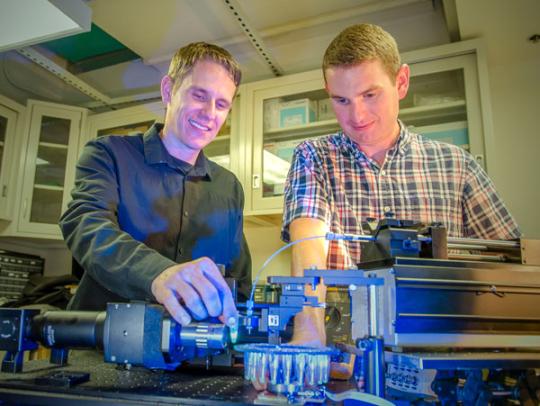Engineering Students Help Biologists to Develop a New Method to Investigate Protein Structure
X-ray footprinting mass spectrometry (XFMS) is a relatively new method to investigate structural features and conformational changes of macromolecules in the solution state. This technique is an innovative way to precisely probe proteins and their surroundings using X-rays. One of the most recent applications of XFMS is understanding how to redesign proteins with the capacity to transfer electrons to mineral surfaces and thus developing bioelectronic sensors. Other applications include determining how ion channel proteins gate molecules in and out of cells, and elucidating how photosynthetic bacteria protect themselves from overexposure to light.
Currently, XFMS is being implemented at Beamline 3.2.1 at the Advanced Light Source (ALS) user facility at Lawrence Berkeley National Laboratory (LBNL). The key issue with XFMS is that the process tends to be highly manual and labor intensive.
This summer two engineering students from Sonoma State University designed and implemented an advanced system that fully automated the XFMS process. While interning at LBNL, Brandon Russell, an undergraduate senior engineering student, and Matthew Rosi an MS-CES graduate student, together with researchers and scientists in the Molecular Biophysics and Integrated Bioimaging (MBIB) Division developed a fast high precision hardware-software platform that can be attached to the X-ray beamline, providing high dose exposure and fast handling of multiple samples. The technology is applicable to a broad range of scientific areas making it accessible to a much wider scientific community than previously possible.
"The newly automated system is a significant change in using the way the Beamline is used and XFMS is applied. The new system can speed up the process by 30-45 times and this is an incredible improvement for scientists and researchers from around the world using the beamline. We plan to duplicate a similar technology at the Brookhaven National Laboratory," said Corie Ralston, the Head of the Berkeley Center for Structural Biology. "With the new instrumentation developed by Matthew and Brandon, structural biologists across the country will be able to apply the method of XFMS in their research programs."
"We are very excited about this new instrumentation. In the future we will expand the experiment even further with implementation of a mixing cell and automated data analysis," said Sayan Gupta, an X-ray footprinting expert, and a Research Scientist at Molecular Biology and Integrated Bioimaging Division at LBNL.
Both Matthew and Brandon have been invited to visit the Brookhaven National Laboratory in September to evaluate and test the performance of their platform on the existing XFP beamline.
"My experience at Lawrence Berkeley National Laboratory has given me the chance to use my classroom knowledge to solve real world problems. I have had a chance to experience the unique challanges of developing a system outside of a lab setting," expressed Brandon.
"While engaged in the project, I was able to acquire a knowledge of biology that I had not previously been exposed to. This, combined with the experience of working at a national laboratory, has led to an extremely fulfilling and rewarding experience that has directly improved my professional development," pointed out Matt.
"The work by these two young engineers is yet another testament to the strong talent that exists at Sonoma State University. Our focus on combining fundamentals and hands-on-training, as well as developing relevant industry skills put our students in a unique position to stand out," said Farid Farahmand, the Chair of the Engineering Department.
Join us to congratulate these two talented students for their great work! We are so proud of them!



